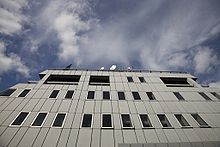Met Éireann
 | |
| Agency overview | |
|---|---|
| Formed | 1936 |
| Preceding Agency |
|
| Jurisdiction | Ireland |
| Headquarters | Meteorological Centre, 65–67 Glasnevin Hill, Dublin 9, D09 Y921 53°22′33″N6°16′11″W/ 53.37583°N 6.26972°W |
| Minister responsible | |
| Agency executive |
|
| Parent department | Department of Housing, Local Government and Heritage |
| Website | www |
Met Éireann(Irish pronunciation:[mʲɛtʲˈeːɾʲən̪ˠ];meaning "Metof Ireland ") is the statemeteorologicalservice ofIreland,part of theDepartment of Housing, Local Government and Heritage.
History[edit]

The history of modern meteorology inIrelanddates back to 8 October 1860, when the first weather observations were transmitted from Valentia Observatory onValentia IslandinCounty Kerryto the BritishMeteorological Office.A network of weather stations was established around the coasts of the United Kingdom of Great Britain and Ireland.[1]
Following the independence of most ofIrelandas theIrish Free Statein December 1922, the new Free State continued to rely on the British Met Office for weather services, and the Met Office continued to administer the weather stations around the Free State. With the advent of transatlantic air services in the 1930s, it was decided that Ireland needed its own weather service to provide detailed aviation weather reports.
In 1936, theIrish Meteorological Servicewas set up, with its headquarters in St. Andrew's Street,Dublin.In 1937, it took over the network of weather stations from the British Met Office. On the date of transfer, the Irish weather observation network consisted of the following stations:[1]
- Valentia Observatory, then the only permanently staffed weather station
- 4 telegraphic stations (atMalin Head,Blacksod Point,Roche's PointandBirr)
- 18 climatological stations
- 172 rainfall stations
At first, the new weather service was bolstered by Met Office employees seconded from London, but by 1941 they were able to depend on their own resources. During 'the Emergency' (as theSecond World Warwas referred to in theneutral part of Ireland), the Irish Meteorological Service supplied theAllieswith weather information despite theofficial neutrality of Ireland.The decision to go ahead with theD-day landingswas made following a favourable weather report from the Blacksod Point weather station inCounty Mayo.[2]
The service expanded rapidly in the post-war years, with its headquarters relocating toO'Connell Street,oppositeThe Gresham Hotelin Dublin.[3]The service began supplying forecasts toRadio Éireannfrom 1948, todaily newspapersfrom 1952, to television from shortly after the firstRaidió Teilifís Éireann(RTÉ) television broadcasts in 1962, and recorded telephone forecasts in the 1960s.Irelandjoined theWorld Meteorological Organisationin the 1950s, and was a founder member of theEuropean Centre for Medium-Range Weather Forecastsin 1975 andEUMETSATin 1983.[1]
In 1979, the service moved to new purpose-built premises inGlasnevin,Dublin, designed byLiam McCormick(primarily known for his ecclesiastical buildings inUlster). In 1996 the service was renamed toMet Éireann.[1]
Met Éireann launched their first website in 2001. In addition to the website they now also have Mobile Apps for Android[4]and iOS[5]developed by FUSIO.[6]
Activities[edit]


Forecasting methodology[edit]
Met Éireann uses theHIRLAMweather model for short-term forecasts (up to 48 hours). This model is developed cooperatively by multiple European weather services. Met Éireann runs a 10 km resolution HIRLAM model four times daily. The operational running of this model has been managed by theIrish Centre for High-End Computing(ICHEC) since 2005.[7]Met Éireann and ICHEC are working on bringing a 5 km resolution HIRLAM model into production by the end of 2010.[needs update]
For medium-term forecasts (between 48 hours and approximately two weeks),Ireland,along with 17 other European states, relies on forecasts provided by theEuropean Centre for Medium-Range Weather Forecastsin theUnited Kingdom.[8]
Climate supercomputer
In November 2021, Met Éireann partnered up with the met offices ofIceland,Denmarkand theNetherlandsto create a supercomputer to give more accurate short term weather readings in the face ofClimate Change.[9]It will be up by 2023 and will be powered by Icelandic 100% green electricity.
Observing stations[edit]
- Belmullet,County Mayo
- Ballyhaise,County Cavan
- Gurteen,County Tipperary
- Claremorris,County Mayo
- Roche's Point,County Cork
- Sherkin Island,County Cork
- Mace Head,County Galway
- Oak Park,County Carlow
- Malin Head,County Donegal
- Mullingar,County Westmeath
- Johnstown Castle,County Wexford
- Valentia Observatory,Cahirciveen,County Kerry[10]
The service also runs many more automated observation stations around the State, including –
- Moorepark,Fermoy,County Cork
- Grange,Dunsany,County Meath
- Mount Dillon,County Longford
- Markree Castle,County Sligo
- Finner Camp,County Donegal
- Athenry,County Galway
Aviation forecasting[edit]
AsIrelandis strategically located on the busy air routes between North America and Europe, aviation forecasting is an important part of Met Éireann's work. In 2005, the service received payments of €7.8 million from theEurocontrolair traffic control authority.[8]Aviation weather offices are located atCasement Aerodrome,Cork Airport,Dublin Airport,Ireland West Airport KnockandShannon Airport.
As of 2016[update],the director of Met Éireann is Eoin Moran. According to the Met Éireann's annual report for 2005, the service had a budget of €20.6 million for that year.[8]
References[edit]
- ^abcdOur History – About Us – Met Éireann— Met Éireann website, retrieved 11 April 2022.
- ^page 180, Duggan, John P."Herr Hempel at the German Legation in Dublin 1937 – 1945"(Irish Academic Press) 2003ISBN0-7165-2746-4.(Review)
- ^Sticks to satellitesRTÉ. Retrieved: 2014-03-31.
- ^"Met Éireann – Apps on Google Play".
- ^"Met Éireann Weather Ireland".
- ^"Met Éireann".
- ^ICHEC TestimonialArchived13 June 2010 at theWayback Machinepage 3, Ray McGrath, Head of Research and Applications Division, Met Éireann, retrieved 22 July 2010.
- ^abc"Met Éireann Annual Report 2005"(PDF).Archived fromthe original(PDF)on 22 May 2012.Retrieved31 December2006.
- ^"Met Éireann joins forces over climate, forecasting supercomputer".www.rte.ie.RTÉ. 10 November 2021.Retrieved14 November2021.
- ^Named for its original location onValentia Island,County Kerry. Moved to its current location on the mainland in 1892.[1].
